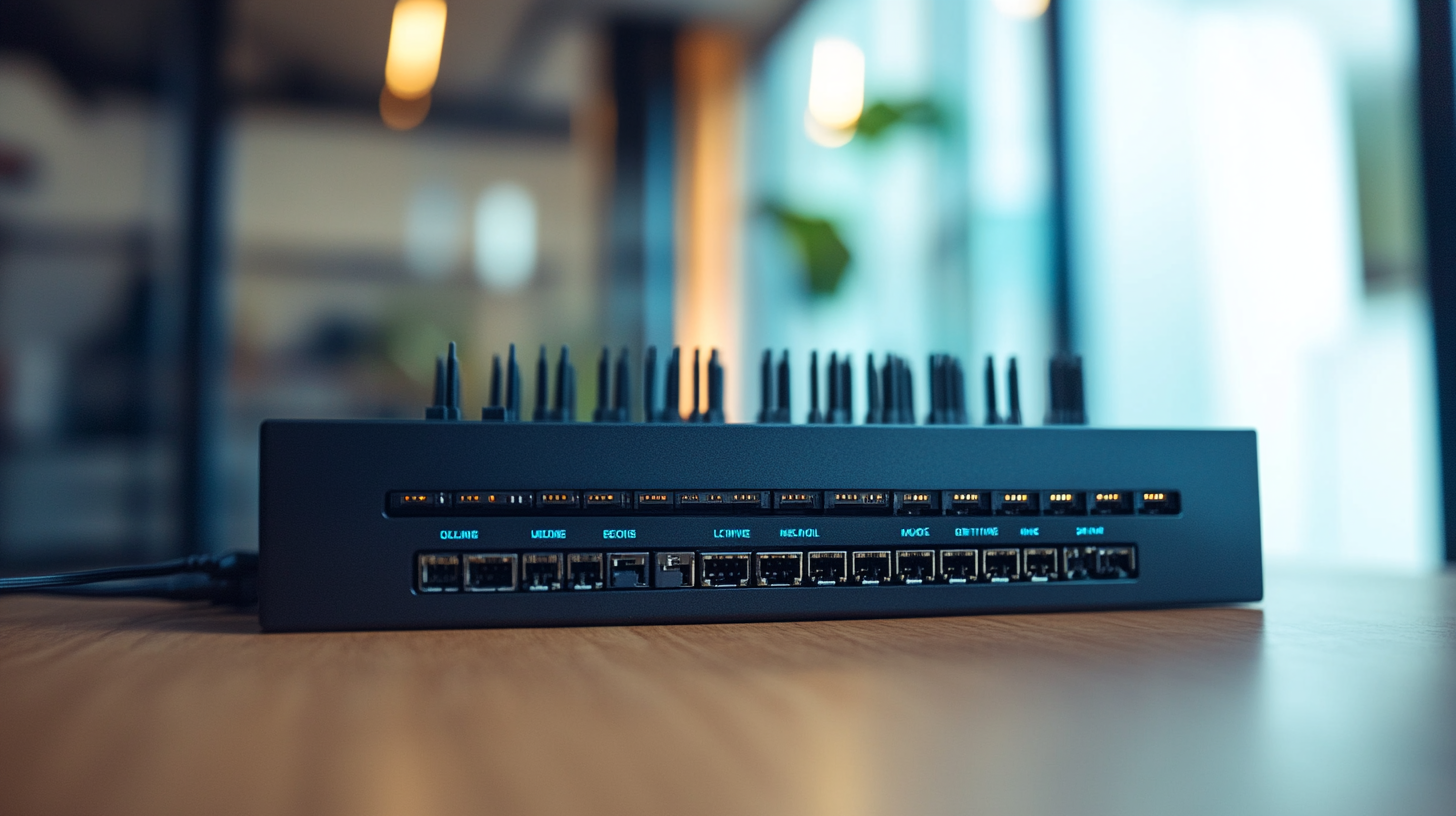
- hasivo@hasivo.com
- Mon - Sat at 7:00AM to 9:00PM
Leave Your Message

In today's increasingly connected world, businesses are recognizing the critical importance of robust networking infrastructure. According to a recent report by MarketsandMarkets, the global managed switches market is expected to grow from USD 9.51 billion in 2020 to USD 18.28 billion by 2025, reflecting an annual growth rate of 14.1%. This growing demand highlights the essential role that Managed Switches play in facilitating efficient data transmission, enhancing network security, and ensuring reliable connectivity for organizations of all sizes. As businesses strive for digital transformation, the adoption of Managed Switches is becoming a strategic choice to optimize their network performance.
Managed Switches offer a tailored networking solution that empowers IT administrators to configure, manage, and troubleshoot their networks with ease. IDC reported that organizations employing managed network solutions experience a 40% reduction in networking costs and a significant improvement in operational efficiency. The flexibility of Managed Switches allows for advanced features such as VLAN tagging, Quality of Service (QoS) support, and enhanced security measures, ultimately leading to a more resilient and high-performing network environment. As we delve deeper into the myriad benefits of Managed Switches, it becomes clear that they are not just a technological upgrade, but a critical investment for future-proofing business operations.

Managed switches are essential tools for enhancing network performance and reliability. With the increasing complexity of network infrastructures, businesses need to prioritize efficient data handling and seamless connectivity. According to research, organizations that deploy managed switches experience up to 30% higher network availability compared to those using unmanaged alternatives. This reliability is crucial in today’s digital landscape where downtime can lead to significant revenue loss and reduced productivity. One of the standout benefits of managed switches is their ability to support advanced features such as VLANs, Quality of Service (QoS), and network monitoring. These functionalities allow network administrators to prioritize critical traffic, streamline operations, and maintain robust security protocols. A recent industry report highlights that organizations utilizing managed switches see a 20% improvement in bandwidth utilization, enabling better performance for applications like cloud services and collaborative platforms. The flexibility of managed switches also contributes to their appeal. With options for integration into cloud environments, these switches facilitate seamless scalability, accommodating the growth needs of small and medium-sized businesses. As reported, businesses can expand their infrastructure without disrupting existing operations, further solidifying managed switches as pivotal in modern networking strategies. This adaptability ensures that as technology evolves, businesses remain prepared to enhance their network performance and security.

When considering networking solutions, cost efficiency is a critical factor that can dramatically affect operational expenses. Managed switches have emerged as a strategic investment for businesses aiming to optimize their network performance while keeping costs down. According to a report by the International Data Corporation (IDC), organizations that implement managed switches can reduce their networking costs by up to 30% compared to unmanaged alternatives. This significant savings is primarily achieved through enhanced troubleshooting and reduced downtime.
Managed switches offer advanced features such as network monitoring and management tools that facilitate proactive maintenance. By identifying and resolving network issues before they escalate, IT teams can minimize disruptions. A study by Gartner highlights that effective management of network infrastructure can lead to a reduction in operational expenses by as much as 25%. This is particularly relevant in today’s business landscape where every minute of downtime can translate into considerable financial losses.
Moreover, the scalability of managed switches allows businesses to adapt their networking solutions as they grow, eliminating excessive capital expenditure on infrastructure. Research from Forrester shows that organizations leveraging scalable managed switch solutions reduce the need for frequent upgrades and replacements, consequently saving on long-term costs. By investing in managed switches, companies not only enhance their networking capabilities but also position themselves for more efficient and cost-effective operations in the future.

In today’s digital landscape, enhancing network security is paramount, and managed switches play a crucial role in this endeavor. These devices not only optimize traffic management but also integrate advanced security features that bolster the overall protection of your network infrastructure. With malicious cyber threats on the rise, the provisioning of managed switches equipped with state-of-the-art security protocols can significantly reduce vulnerabilities within a network.
One of the latest advancements in network security is the implementation of WPA3, the newest standard for Wi-Fi Protected Access. By leveraging WPA3, alongside managed switches, organizations can establish a fortified defense mechanism against unauthorized access and data breaches. Managed switches enable the configuration of VLANs and Access Control Lists (ACLs), providing a layered security approach that isolates sensitive data and restricts access to critical resources.
Additionally, the trends toward next-generation firewalls and AI-driven security solutions complement managed switches in creating a robust security posture. The evolution of these technologies allows organizations to not only detect but also proactively respond to threats in real-time. By choosing managed switches that support these advanced features, businesses can unlock a secure networking environment, protecting both their data and their reputational integrity.

As businesses evolve in a rapidly changing technological landscape, the need for scalable and flexible networking solutions has never been more critical. Managed switches have emerged as a vital component in addressing these challenges, offering businesses the ability to expand their networks seamlessly. According to a report by ResearchAndMarkets, the global managed switch market is projected to grow from $5.67 billion in 2020 to $10.28 billion by 2026, reflecting a compound annual growth rate (CAGR) of 10.56%. This growth underscores the increasing demand for solutions that adapt to expanding network requirements.
Managed switches provide an array of features that contribute to their scalability and flexibility. Organizations can easily segment networks into virtual LANs (VLANs), manage bandwidth effectively, and prioritize traffic with Quality of Service (QoS). These capabilities ensure that as a business grows, its network can handle increased data volumes and critical applications without compromising performance. According to Gartner, 70% of companies report improved operational efficiency after implementing managed switches, highlighting the significance of these tools in optimizing network performance.
Moreover, with the rise of cloud computing and the Internet of Things (IoT), businesses are required to support a multitude of devices and applications. Managed switches facilitate this by allowing for centralized management and control, which simplifies network adjustments as needs evolve. A recent study by IDC suggests that 60% of IT decision-makers believe that investing in managed networking solutions is essential for future-proofing their infrastructure, reinforcing the notion that scalability and flexibility are paramount in today’s digital environment. This investment not only enhances network performance but also ensures that organizations can adapt to technological advancements and growth opportunities effectively.
In today’s networking landscape, efficient data traffic management is crucial for organizations aiming to maintain seamless operations. Managed switches offer an advanced solution by incorporating Quality of Service (QoS) features, ensuring that data packets are prioritized based on urgency and application needs. According to the International Data Corporation (IDC), 77% of businesses acknowledge that improved QoS can enhance application performance and increase productivity. This highlights the growing importance of sophisticated network management tools in minimizing latency and maximizing throughput.
Implementing QoS in managed switches allows organizations to efficiently allocate bandwidth to critical applications, such as VoIP and video conferencing, which are sensitive to delays. A report from the Gartner Group states that a well-implemented QoS can reduce packet loss by up to 50%, significantly improving the user experience. Additionally, with the emergence of IoT and smart devices, managing data traffic becomes even more vital, as these devices continuously generate data traffic that requires real-time processing. By leveraging QoS capabilities, businesses can ensure that essential applications remain uninterrupted, even during peak usage.
Furthermore, as data traffic continues to surge—with a projected annual growth rate of 25% in enterprise networks, as noted by Statista—managing this influx effectively is paramount. Managed switches empower network administrators to define bandwidth allocation rules, monitor network performance, and troubleshoot issues proactively. By embracing these technologies, organizations can enhance overall network efficiency and ensure optimal performance in an increasingly data-driven world.